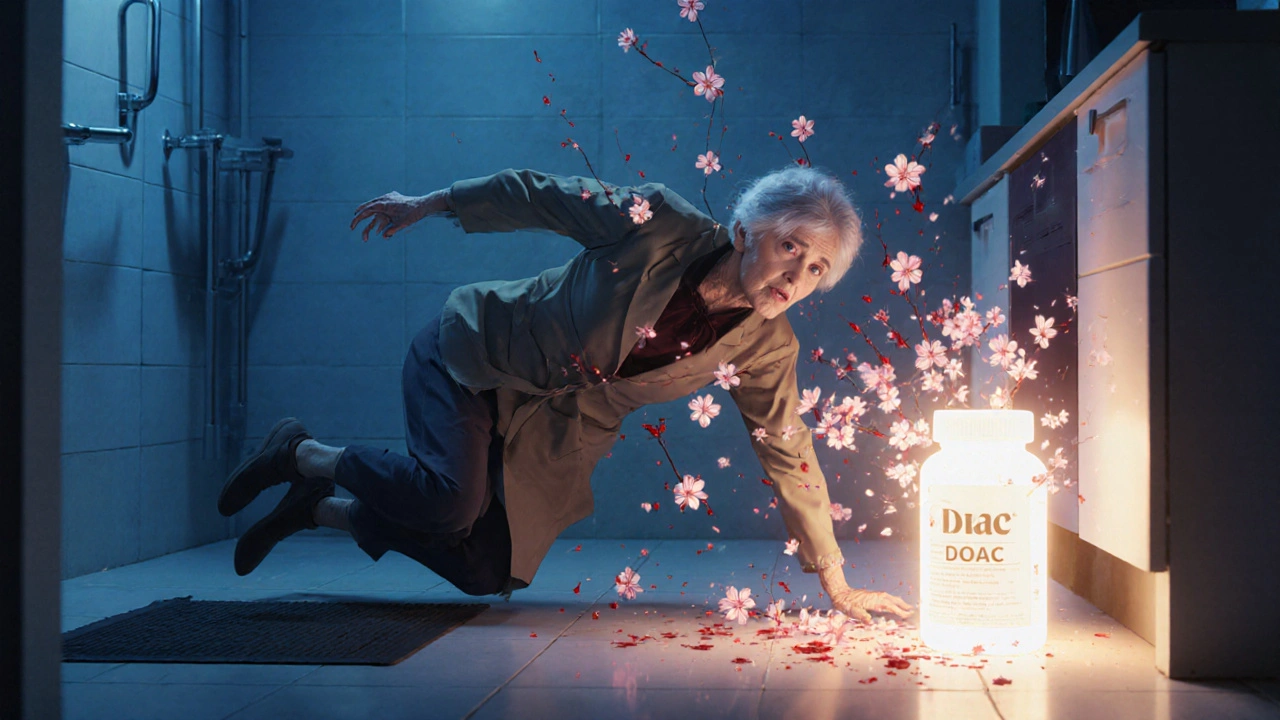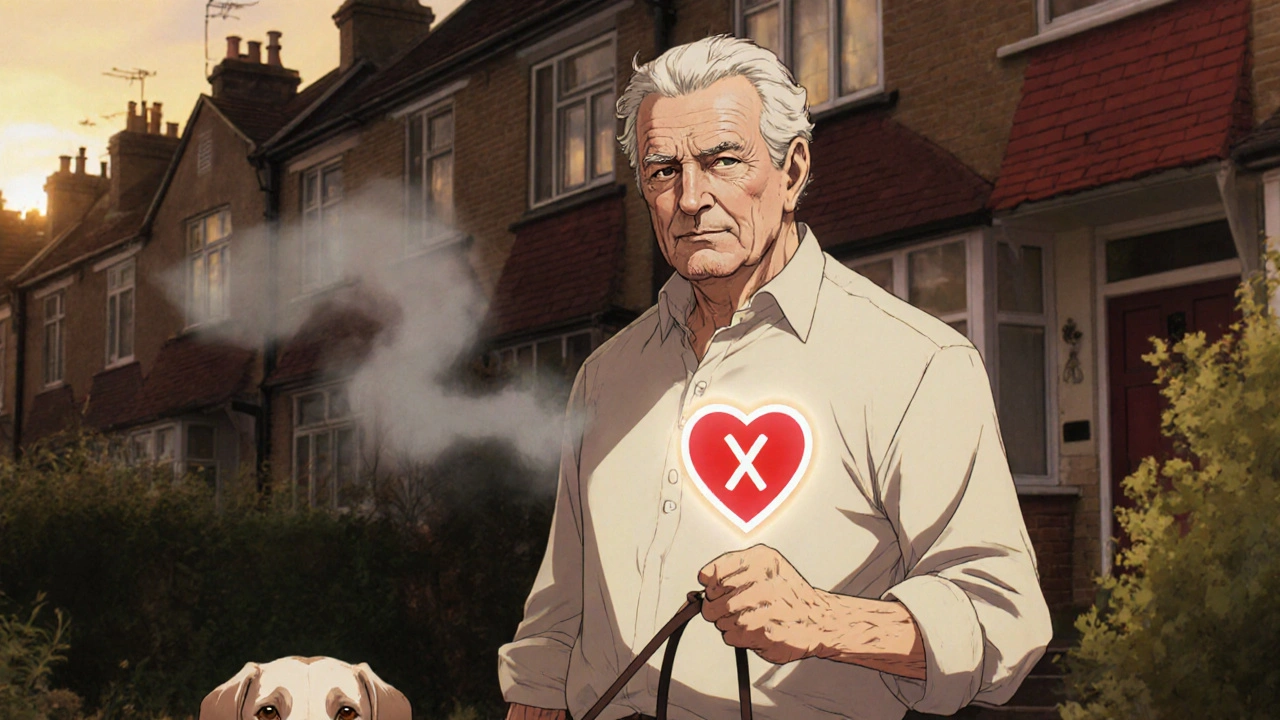Every year, thousands of seniors in the UK and beyond are told to stop their blood thinners because they’ve had a fall. It sounds logical-why risk a bleed if you’re prone to tripping? But here’s the hard truth: anticoagulants save more lives than they endanger in older adults with atrial fibrillation. The fear of falling shouldn’t override the risk of stroke-especially when the numbers don’t lie.
Why Anticoagulants Are Necessary for Seniors with Atrial Fibrillation
Atrial fibrillation (AFib) isn’t just an irregular heartbeat. It’s a silent threat. In people over 65, nearly 1 in 10 has it. And with each passing decade, the chance of a stroke climbs sharply: 1.5% at age 50-59, nearly 10% by 70-79, and over 23% by 80-89. That’s not a small risk. That’s a ticking time bomb. Anticoagulants, or blood thinners, cut that stroke risk by about two-thirds. Warfarin, used since the 1950s, still works. But newer drugs-apixaban, rivaroxaban, dabigatran, edoxaban-are now preferred for most seniors. They don’t need constant blood tests, they’re easier to manage, and they cause fewer deadly brain bleeds than warfarin. The evidence is overwhelming. In the BAFTA trial, seniors with an average age of 81.5 who took anticoagulants had a 52% lower risk of stroke or blood clots than those on aspirin. And here’s the kicker: there was no significant rise in major bleeding. The same pattern held in studies of people over 85 and even 90. The oldest patients got the most benefit.The Fall Risk Myth: Why Stopping Anticoagulants Is Often the Bigger Danger
It’s easy to panic when a loved one tumbles. But falls don’t cause strokes. Anticoagulants don’t cause falls. What they do is make bleeding worse if a fall happens. That’s the real concern. Yes, seniors on anticoagulants are more likely to have a serious bleed after a fall. Minnesota hospital data shows they’re 50% more likely to suffer a brain bleed than those not on blood thinners. And 90% of fall-related deaths involve people over 85 or those on anticoagulants. Those numbers are scary. But here’s what most people miss: the chance of having a stroke without anticoagulants is far higher than the chance of dying from a fall while on them. A 2023 review in the Journal of Hospital Medicine called stopping anticoagulants due to fall risk “inappropriate practice.” Why? Because the math doesn’t add up. For every 100 octogenarians treated with a DOAC for a year, 24 strokes are prevented. Three major bleeds occur. That’s a net gain of 21 lives saved or disabilities avoided. The American College of Cardiology, the American Heart Association, and the Heart Rhythm Society all agree: age and fall history are not reasons to withhold anticoagulation. In fact, the older you are, the more you stand to gain.
Choosing the Right Anticoagulant: DOACs vs. Warfarin
Not all blood thinners are the same. Warfarin works well, but it’s fussy. You need frequent blood tests to keep your INR between 2.0 and 3.0. Most seniors only stay in range about 60-65% of the time. That means unpredictable clotting or bleeding risk. DOACs (direct oral anticoagulants) changed the game. Apixaban, for example, reduces stroke risk by 21% compared to warfarin and cuts major bleeding by 31% in people over 75. Rivaroxaban lowers the risk of deadly brain bleeds by 34%. Dabigatran and edoxaban are also effective, with fewer interactions than warfarin. But they’re not perfect. Most DOACs are cleared by the kidneys. As we age, kidney function drops. A creatinine clearance below 50 mL/min means dose adjustments are needed. That’s why checking kidney function every 6-12 months is standard. There’s also the issue of reversal. Warfarin can be reversed quickly with vitamin K and fresh plasma. DOACs used to be harder to reverse-until 2015, when idarucizumab (for dabigatran) and andexanet alfa (for apixaban, rivaroxaban, edoxaban) became available. Now, if a major bleed happens, doctors have tools to act fast.How to Reduce Fall Risk Without Stopping the Medication
You don’t have to choose between stroke prevention and safety. You can do both. Start with a fall risk assessment. Tools like the Morse Fall Scale or the Hendrich II Fall Risk Model help identify risks: poor balance, vision problems, muscle weakness, home hazards. Don’t just assume “old age” is the cause. Then, fix what you can:- Remove throw rugs and clutter
- Install grab bars in bathrooms
- Improve lighting, especially at night
- Use non-slip mats in showers
- Review all medications-benzodiazepines, sleep aids, and painkillers can make you dizzy
When Clinicians Get It Wrong-and How to Advocate
Despite the guidelines, many doctors still hesitate. A 2021 survey found 68% of primary care physicians would deny anticoagulation to an 85-year-old with two falls-even if their stroke risk score (CHA₂DS₂-VASc) was 4, which means high risk. That’s not based on evidence. It’s based on fear. If your parent or relative has AFib and was told to stop anticoagulants because of falls, ask: “What’s their CHA₂DS₂-VASc score?” If it’s 2 or higher, anticoagulation is recommended. Ask: “Have we tried a DOAC?” Ask: “Have we looked at fall prevention strategies?” Don’t accept “it’s too risky” as an answer. The evidence says it’s riskier not to treat.The Bottom Line: Balance, Not Avoidance
Anticoagulants aren’t a one-size-fits-all solution. But for seniors with atrial fibrillation, they’re one of the most effective tools we have. The goal isn’t to eliminate all risk-it’s to manage it wisely. Use a DOAC if possible. Monitor kidney function. Reduce fall hazards. Get moving. Review meds. And never stop anticoagulation just because someone fell. The numbers don’t lie. For every 20 elderly patients treated with anticoagulants, one stroke is prevented each year. That’s not just a statistic. That’s a grandfather who walks his dog. A grandmother who attends her granddaughter’s wedding. A life that continues. The choice isn’t between falling and not falling. It’s between living-and dying from a stroke that could have been prevented.Should seniors stop anticoagulants after a fall?
No. A single fall or even multiple falls are not reasons to stop anticoagulants in seniors with atrial fibrillation. The risk of stroke without treatment is far greater than the risk of a serious bleed from a fall. Clinical guidelines from the American College of Cardiology and others state that fall history should not override stroke prevention benefits. Instead, focus on preventing future falls through home safety, exercise, and medication review.
Are DOACs safer than warfarin for elderly patients?
Yes, for most seniors. DOACs like apixaban and rivaroxaban have lower risks of brain bleeds and don’t require frequent blood tests. Apixaban reduces major bleeding by 31% compared to warfarin in patients over 75. DOACs are also less affected by diet and other medications. However, they rely on kidney function, so regular creatinine checks are needed. Warfarin may still be used if a patient has severe kidney disease or can’t afford DOACs.
How often should kidney function be checked in seniors on DOACs?
Every 6 to 12 months, or more often if kidney function is declining. Most DOACs are cleared by the kidneys, and age-related decline can reduce their clearance, increasing bleeding risk. If creatinine clearance drops below 50 mL/min, the dose usually needs to be lowered. Some DOACs, like apixaban, can be used safely at lower doses in patients with moderate kidney impairment.
What’s the CHA₂DS₂-VASc score, and why does it matter?
The CHA₂DS₂-VASc score estimates stroke risk in people with atrial fibrillation. Points are added for congestive heart failure, high blood pressure, age (75+ = 2 points, 65-74 = 1), diabetes, prior stroke, vascular disease, and female sex. A score of 2 or higher means anticoagulation is recommended. For an 80-year-old woman with AFib, the score is often 5 or higher-making anticoagulants essential. A low score (0-1) may mean aspirin or no treatment is acceptable.
Can seniors on anticoagulants still drive?
Yes, unless they have other conditions that impair driving-like severe dizziness, vision loss, or recent stroke. Anticoagulants themselves don’t affect reaction time or alertness. However, if a senior has had a recent fall or bleed, their doctor may temporarily advise against driving until stability is confirmed. Always follow local regulations; in the UK, the DVLA requires notification of certain medical conditions, but anticoagulant use alone doesn’t require reporting.
What should I do if my elderly relative has a serious fall while on anticoagulants?
Seek immediate medical attention. Even if there are no obvious injuries, internal bleeding-especially in the brain-can develop slowly. Tell emergency staff the person is on a blood thinner and which one. If it’s a DOAC, mention the name (e.g., apixaban, rivaroxaban). Hospitals now have reversal agents available: idarucizumab for dabigatran and andexanet alfa for factor Xa inhibitors. Time matters, so don’t wait for symptoms like confusion, headache, or weakness.
Are there any natural alternatives to anticoagulants for stroke prevention?
No. There are no proven natural alternatives that match the effectiveness of anticoagulants for stroke prevention in atrial fibrillation. Supplements like fish oil, garlic, or turmeric have mild blood-thinning effects but are not strong enough to prevent strokes in AFib. Relying on them instead of prescribed medication increases stroke risk dramatically. Aspirin is not a substitute-it only reduces stroke risk by 22%, compared to 64% with anticoagulants.
How do I know if my senior loved one is on the right anticoagulant?
Ask their doctor for their CHA₂DS₂-VASc score and HAS-BLED score. If their stroke risk is high (CHA₂DS₂-VASc ≥2) and their bleeding risk is low to moderate (HAS-BLED ≤3), a DOAC is usually the best choice. If kidney function is impaired, apixaban is often preferred because it’s less dependent on the kidneys. If cost is an issue, warfarin may still be used-but only if INR monitoring is reliable. Never switch or stop without medical advice.







robert cardy solano November 20, 2025
My grandma’s on apixaban and she’s 89. Fell twice last year-once down the basement steps, once tripping over the cat. Didn’t stop the med. She’s still walking the dog, gardening, and yelling at the TV during bingo night. The docs were scared, but the numbers don’t lie. She’s had zero bleeds. Just more stubbornness than the average 89-year-old.
Stop anticoagulants because of falls? That’s like refusing to drive because you almost hit a squirrel once.
Pawan Jamwal November 20, 2025
INDIA IS THE ONLY COUNTRY WHERE OLD PEOPLE LIVE WITH THEIR KIDS AND GET PROPER CARE 😤 WHY ARE AMERICANS SO STUPID THEY THINK FALLS = STOP MEDS? 🤬
Here, we have 3 generations under one roof. Grandpa takes his DOAC, grandma massages his legs, uncle fixes the rugs, auntie checks his creatinine. No one stops meds because of a stumble. We don’t treat elders like fragile china-we treat them like FAMILY. 🇮🇳❤️
Bill Camp November 21, 2025
THIS IS WHY AMERICA IS FALLING APART. 🚨
Doctors are scared of lawsuits, so they let people die from strokes because they’re too chicken to keep a blood thinner on an 82-year-old who tripped over a rug. The VA’s doing this. Medicare’s doing this. Hospitals are doing this. And the worst part? The patients don’t even know they’re being denied life-saving care.
We need a national campaign. A billboard. A TV ad. ‘YOUR GRANDPA COULD BE ALIVE IF YOU HADN’T LISTENED TO A COWARD.’
Lemmy Coco November 22, 2025
i just read this and wow. my dad’s on rivaroxaban and his doc said ‘maybe we should hold off after your fall’ and i was like… wait what? i looked up the bafta trial and was like ohhhhhhh. so i printed the paper and showed him. he’s still on it. kidney’s fine, falls are fewer since we got rid of the throw rug. thanks for the info. i think i just saved his life 😅
ps: typo on ‘dabigatran’ in my notes lol
rob lafata November 24, 2025
Let me get this straight-you’d rather let your 84-year-old have a stroke because they’re ‘too clumsy’? That’s not care, that’s surrender wrapped in fear.
And don’t even get me started on the doctors who think ‘old age’ is a diagnosis. It’s not. It’s a risk factor. And risk factors are managed, not avoided like a bad date.
Also, ‘fall risk’ is code for ‘I don’t want to deal with the paperwork.’ You think a hip fracture is easier to manage than a stroke? Try rehabbing a broken hip at 87 while your brain’s turned to mush from an embolism. That’s not a ‘choice.’ That’s negligence dressed in white coats.
And for the love of god, if your grandma’s on warfarin and you’re not tracking INR, you’re not managing risk-you’re playing Russian roulette with a loaded gun. DOACs aren’t magic. But they’re better than your grandma’s 1998 blood test results.
Matthew McCraney November 25, 2025
THEY’RE LYING TO YOU. 🤫
Big Pharma doesn’t want you to know DOACs are just fancy placebos with a $300 price tag. The real reason they push them? So you don’t need INR tests. No tests = no oversight = no accountability. And who gets hurt? The old folks. The ones who can’t read the labels.
And what about the reversal agents? Andexanet? Idarucizumab? They cost $50K a dose. Who pays? YOU. The system. The taxpayer. The nursing home.
They’re selling you a dream. A dream where your grandpa lives longer… but your credit card dies first. 🕵️♂️💊
Warfarin is cheaper. Warfarin is tested. Warfarin is real. The rest? Corporate magic.
serge jane November 26, 2025
It’s funny how we treat aging like a disease to be cured rather than a process to be honored. We obsess over preventing death instead of honoring life.
Yes, anticoagulants prevent strokes. Yes, falls are dangerous. But what are we really trying to protect? A calendar date? Or the dignity of someone who still wants to taste their granddaughter’s cake? Or walk to the mailbox? Or sit in the sun without fear?
Maybe the real question isn’t whether to keep the blood thinner. Maybe it’s whether we’ve built a world where an 88-year-old can fall without becoming a statistic.
Medicine gives us tools. But humanity gives us purpose.
Don’t just manage risk. Manage love.
And yes, I know I’m being poetic. But someone has to say it.
Nick Naylor November 26, 2025
DOACs: Direct Oral Anticoagulants. Not ‘magic bullets.’ Not ‘silver platters.’ Not ‘easy fixes.’ They are pharmacological interventions with specific pharmacokinetic profiles, renal clearance dependencies, and reversal agent requirements. The clinical guidelines from ACC/AHA/HRS are evidence-based, guideline-driven, and risk-stratified. The CHA₂DS₂-VASc score is validated, calibrated, and externally verified. The HAS-BLED score is not a suggestion-it is a clinical decision-making framework. Misinterpretation of ‘fall risk’ as a contraindication is not merely inappropriate-it is a deviation from standard of care, and in some jurisdictions, may constitute negligence.
And for the record: ‘throw rugs’ are not ‘home hazards.’ They are biomechanical tripping vectors. Fix them. Don’t stop the drug.
Brianna Groleau November 28, 2025
I’m a nurse in a senior center. I’ve seen this play out too many times. A woman, 86, had a stroke after her doctor told her to stop apixaban because she fell in the shower. She couldn’t speak. Couldn’t move her right side. Couldn’t hug her grandkids.
Meanwhile, the man next to her-same age, same AFib, same fall history-stayed on rivaroxaban. He walks the halls with his walker. Still jokes with the aides. Still argues about the weather with the guy who sits across from him.
It’s not about the medication. It’s about the mindset. Do we see elders as people who deserve to live? Or as problems to be minimized?
Fix the home. Fix the balance. Fix the meds. Don’t fixate on fear.
And if you’re reading this and you’re a family member? Speak up. Even if you’re scared. Even if you’re not ‘medical.’ You know your person better than any algorithm.
Rusty Thomas November 29, 2025
Okay but like… WHAT IF MY GRANDPA JUST DROPPED A BUCKET AND SLIPPED?? 😭
I’m not saying he shouldn’t be on meds. I’m just saying… WHAT IF HE’S JUST… CLUMSY?? 😭
Like… I cried when he fell. I thought he was gonna die. I didn’t know if I should even let him get out of bed. I thought stopping the pill was the ‘safe’ choice. I didn’t know about DOACs. I didn’t know about the stats. I just knew I couldn’t lose him.
But now I know. And I’m so mad at myself for even thinking about it.
He’s back on apixaban. We put in grab bars. We got him a cane. He’s walking again. I’m still scared. But I’m not stopping the meds. I’m not letting fear win.
Thank you for this post. I needed it.
😭❤️
Sarah Swiatek December 1, 2025
Oh sweetie, you think the doctors are the problem? Nah.
The problem is the system that gives them 8 minutes per patient. The problem is the insurance that won’t cover home safety assessments. The problem is the family that says ‘let’s just stop it’ because they can’t handle the anxiety.
I’ve had 85-year-old patients on DOACs for 7 years. One fell down the stairs. Broke her hip. Had a brain bleed. Lived. Walked again. Still takes her pill. Still argues with her cat.
Meanwhile, the ones who stopped? They’re either dead or in a nursing home with a feeding tube.
So yeah, the meds aren’t the villain. The fear is. And fear is lazy.
Do the work. Fix the rugs. Get the PT. Check the kidneys. And then-then-let the science speak.
Dave Wooldridge December 1, 2025
THEY’RE HIDING THE TRUTH. 🤫
DOACs aren’t safer. They’re just newer. And new means more testing on younger people. The FDA doesn’t test on 90-year-olds with kidney failure. They test on 50-year-olds who go to the gym.
And the reversal agents? They’re not in every hospital. Not even close. You think your grandma’s ER in rural Ohio has andexanet alfa? No. They have ice packs and prayers.
And what about the cost? $500 a month? For someone on Social Security? That’s not healthcare. That’s extortion.
Warfarin is cheap. Warfarin is proven. Warfarin is REAL. The rest? Marketing. Corporate greed. And a whole lot of fearmongering wrapped in ‘evidence.’
Rebecca Cosenza December 2, 2025
My mom’s on apixaban. Fell last month. No bleed. Still alive. Still taking it. No drama. Just common sense.
Stop anticoagulants for falls? No.
Fix the house. Yes.
Check kidneys. Yes.
But don’t let fear kill her.
❤️
swatantra kumar December 3, 2025
Bro… in India, our grandmas walk barefoot on wet tiles and still take their pills 😂
Here, we don’t stop meds for falls. We fix the floor. We add rails. We teach them to walk slow. We give them protein shakes. We don’t let fear make decisions.
Also, my auntie’s 91, on dabigatran, still plays cards every Friday. She fell last year-broke nothing. Took her pill the next day. Said, ‘Beta, the medicine is my friend.’
USA, you need to chill. 🙏
And yes, I used an emoji. So what? 😎
Cinkoon Marketing December 4, 2025
Interesting post. I work in home care. We’ve seen a lot of this. The thing no one talks about? Many seniors don’t take their meds consistently anyway. Even if you don’t stop the prescription, compliance is a whole other issue.
Also, some families just can’t afford the DOACs. And insurance denies them. So they switch to aspirin. And then wonder why the stroke happens.
It’s not just about the drug. It’s about access. Support. Education. And yes-love.
But hey, at least now we’re talking about it. That’s progress.
robert cardy solano December 5, 2025
My grandma’s on apixaban and she’s 89. Fell twice last year-once down the basement steps, once tripping over the cat. Didn’t stop the med. She’s still walking the dog, gardening, and yelling at the TV during bingo night. The docs were scared, but the numbers don’t lie. She’s had zero bleeds. Just more stubbornness than the average 89-year-old.
Stop anticoagulants because of falls? That’s like refusing to drive because you almost hit a squirrel once.